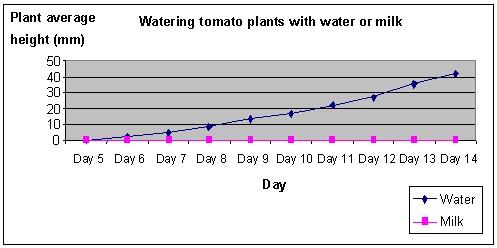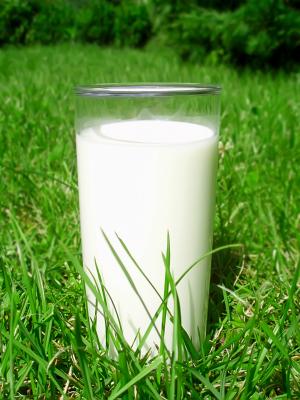| Complexity level: | 4 |
| Project cost ($): | 20 |
| Time required: | 1 day to prepare, 14 days for observation |
| Material availability: | Easily found |
| Safety concerns: | Basic safety requirements |
Hypothesis
Using milk to water plants will help them grow better.
Overview
Milk and plants
Most of the ingredients found in milk are not required by plants. Fat, lactose and carbohydrates found in milk are not essential to plants. Proteins in milk are rich in nitrogen but they are not in a form that plants can synthesize. However, milk contains calcium and some minerals that may help plants grow better.
Plants get most of their nutrition directly from soil. Water is very important for plants to grow and remain healthy. During photosynthesis, plants use water and carbon dioxide to produce sugar and oxygen. Water is also used to transport minerals absorbed from the soil to other parts of the plant. Plants also need water to prevent dehydration and for transpiration.
Scientific Terms
Materials
The materials required for this science fair project:
- 1 packet of tomato seeds
- 2 garden pots
- Soil for the 2 garden pots
- 7 liters of milk (the same type/brand)
- 7 liters of distilled water
- 1 measuring cylinder
- 1 ruler
- 1 black marker pen, and writ
Procedure
1. For this science fair project, the independent variable is the method of watering the tomato plants –using water or milk. The dependent variable is the height of the tomato plant in the pot. This is determined by measuring the height of the plant with a ruler. The constants (control variables) are the environment the pots are kept in (temperature, humidity, light, etc), the number of seeds used, the type of seeds and the size of the pot and the type of soil.
2. The 2 garden pots are labeled as “Water” and “Milk”. Each of the 2 pots is filled with the same amount of soil. Poke 10 holes in the soil in each of the pots (about an inch deep) and place 10 tomato seeds in each of the 2 pots. Cover the holes with soil. Additional seeds may be planted in case some of the seeds do not germinate. The extra plants can be removed later.
3. For the next 14 days, water the first pot daily with 500ml of water and the second with 500ml of milk.
4. Between days 5 to 14, the height of the tomato plants in the pots are measured. The measurements are recorded in the table given below.

Results
It is observed that the tomato plants in the pot that was watered with water grew very well. However, none of the tomato seeds in the pot that was watered with milk germinated. The soil also became very hard and gave off an unpleasant smell.
| Watering | Average height of tomato plants (mm) | |||||||||
| Day 5 | Day 6 | Day 7 | Day 8 | Day 9 | Day 10 | Day 11 | Day 12 | Day 13 | Day 14 | |
| Water | 0 | 2 | 5 | 9 | 13 | 17 | 22 | 27 | 35 | 42 |
| Milk | 0 | 0 | 0 | 0 | 0 | 0 | 0 | 0 | 0 | 0 |
Use the below graph to plot the results of above observation.

Conclusion
The hypothesis that using milk to water plants will help them grow better is disproved.
Watering plants with milk may provide additional nutrients for the soil, but the transpiration of water from the soil may cause the concentration of milk solutes to increase and make it hypertonic. This will make the plant wilt because they cannot absorb water from the soil. Milk will also cause bacteria growth and attract insects that can harm the plant and its roots. Plants watered with milk usually wilt and die after a few days or weeks.
Also consider
Try to repeat the science fair project using other types of plants like radish, chili or sunflower.
Try using 4 or more pots in this experiment – eg. 2 or 3 pots of seeds watered with water, 2 or 3 pots watered with milk – for more accurate results.
The experiment can also be repeated using different concentrations of milk mixed with water.
References
Is water better than milk for plants - http://www.ehow.com/about_5521977_water-better-milk-plants.html
Plants and milk - http://www.bio.net/bionet/mm/plant-ed/1996-February/000470.html

